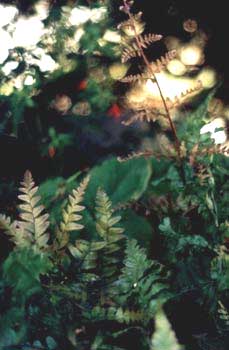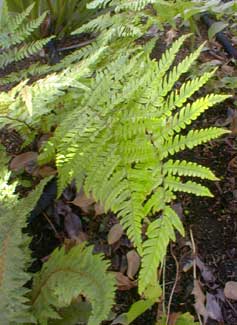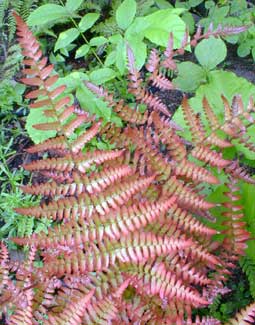 Autumn Fern; aka,
Autumn Fern; aka,
Japanese Red Shield Fern
"Pan, blow your pipes & I will be
Your fern, your pool, your dream, your tree!"
-Leonora Speyer
1872-1956
1872-1956
The Autumn Fern (Dryopteris erythrosora) is native of Japan & China. The genus name Dryopteris means "Oak fern" of which there are many species, & erythrosora means "Red Sori" referring to the reddish spore structure of the underside of the leaves. But its common name Japanese Red Shield Fern is because its youngest leaves as they appear throughout spring are coppery red to bronze or pink in coloration, as seen in the third photo below in June (2005).
 Many ferns have orange fiddleheads that turn green, but the Autumn Fern is much redder & the color lasts a little while beyond the fiddlehead stage. The red colors of young leaves is unique among garden ferns, though the redness is transient, darkening to a normal green as each frond ages through the year. The most often-used common name "Autumn Fern" is for the very reason of its colorfulness, though it has these colors more in spring rather than in autumn. The portrait above left is of its normal coloration in September (2002), & on the right in August (2004).
Many ferns have orange fiddleheads that turn green, but the Autumn Fern is much redder & the color lasts a little while beyond the fiddlehead stage. The red colors of young leaves is unique among garden ferns, though the redness is transient, darkening to a normal green as each frond ages through the year. The most often-used common name "Autumn Fern" is for the very reason of its colorfulness, though it has these colors more in spring rather than in autumn. The portrait above left is of its normal coloration in September (2002), & on the right in August (2004). It is the least tidy of our ferns, having a slightly tangly growth habit. Individual fronds can arch from the crown to tip up to two feet long. Three-foot wide specimens are not uncommon, though two-foot spread is more to be expected. It is semi-evergreen here in the Northwest, getting scruffy toward winter's end with some die-back, & may need most or all of last year's fronds trimmed off when spring's colorful young leaves begin to unfold from fiddleheads. In warmer climates it is fully evergreen but even then usually needs older leaves trimmed for sake of new growth.
It is the least tidy of our ferns, having a slightly tangly growth habit. Individual fronds can arch from the crown to tip up to two feet long. Three-foot wide specimens are not uncommon, though two-foot spread is more to be expected. It is semi-evergreen here in the Northwest, getting scruffy toward winter's end with some die-back, & may need most or all of last year's fronds trimmed off when spring's colorful young leaves begin to unfold from fiddleheads. In warmer climates it is fully evergreen but even then usually needs older leaves trimmed for sake of new growth.It needs considerable shade, & moist organically enriched acidic soil, being a little delicate in that it will not tolerate heat or sun, nor soil that is packed hard or insufficiently enriched or dry or poorly draining. All other conditions being excellent it will still not invarialy thrive in cities where automobile pollution is high. But it's worth the attempt since no other fern matches its spring colors. When it does do well, it is most rewarding.
We got our first one as a little three-dollar plant & tucked it in a well-sheltered area, having heard of its potential delicateness. It was behind an arbor where if it had not grown so nicely it wouldn't have been an eyesoar. Fortunately it grew nicely, but was in such a hidden place we later added two others in another shade garden with more prominant position, filling in as backdrop to a patch of trilliums, dogtooth lilies, & jack-in-the-pulpits that take up much of the foreground.